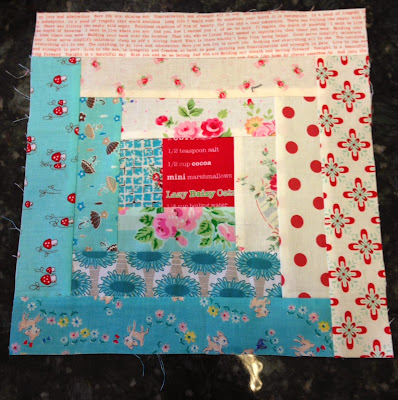Because of lack of material I'm doing a rerun of one of my tutorials. I'm still not able to sit at my machine for very long. Recovery from bursitis isn't very fun. And I'm rather sick of myself not being able to do normal stuff. So I thought I would rewind to a time when I was my old creative self. This is such a fun house block. It makes me feel good to look backwards at all the fun things I've made. The block seemed like a perfect size for a pot holder but the Doll House could be applied to other crafts or quilt blocks.

It was really fun picking out fabric for each house and as with the cottages I enjoyed making each one unique.

Using the mylar batting called
Insul-Bright keeps the potholder thin and light weight like regular cotton Warm and Natural batting. Just an FYI - the mylar batting is not safe in the microwave. I've never microwaved a hot pad, but you just never know. I only use one layer of the batting and I put the more shiny side facing the back. So far it works fine.

Doll House Cutting instructions:
House (1) 6" x 6" square;
Roof (1) 6" x 3" strip;
Background (2) 2 1/2" squares, (2) 8 1/2" x 2" strips, (1) 9" x 2" strip;
Grass (1) 9" x 2" strip;
Door (1) 3 1/2" x 2" rectangle;
Window (1) fussy cut square approximately 2 1/2" or smaller depending on image in window and (optional) trim 7" long.
All seams are 1/4".

Round the upper corners of the door rectangle. Place the door along the bottom edge of the house and in from the right side edge of the house by 3/4". Position the fussy cut window in 3/4" from the left side edge of the house and down 1 1/4" from the top as shown above.
Added note- You can fussy cut more windows and play with the placement. I sometimes put a little window in the attic. It is fun to look at your fabric and think what might be fun to fussy cut and put in the window or door.

Using black thread and your sewing machine's blanket stitch, attach the door and window to the house block.

Press a crease diagonally in the 2 1/2" squares cut from background fabric. With right sides together position the squares over the upper corners of the roof fabric.

Using the crease as a stitching guide, attach the squares to the roof stitching diagonally as above.

Trim to 1/4".

Press seam allowance outward towards the corners. You can see that I tried to center the stripe in the middle but that made the scalloped edge off center - oh well.

With right sides together stitch the roof to the house block. Press.

Trim is optional. Stitch trim just below the seam line below the roof securing both edges of the trim. Next sew the 2 strips of fabric (8 1/2" x 2") to the sides of the house. Press.

Stitch the (9" x 2") back ground strip and the green grass strip to the tops and bottom of the block. Press.

Finished Doll House blocks above. Some of the houses I made in slightly different sizes before I settled on the best size.

Cut a square of the mylar batting and the backing fabric larger than the Doll House block by at least 1" around all the edges. Place your finished Doll House block with mylar batting in between and a linen (or other fabric) backing and pin in place.

Machine quilting this block is very easy. Using a walking foot, stitch in the ditch around all seams, door, window, trim and back ground fabric edges.

Detail of machine quilting shown above in the back of the hot pad fabric.

Trim batting and backing from all sides and square up the Doll House block.

Using a rounded edge template mark a curved edge in each corner of the Doll House block. Cut on marked line as above.

Cut a bias binding and create a 4" long loop with binding fabric. Attach loop to the top of the Doll House block and bind as you would a quilt. Optionally you can sew a tiny button to the door for a door knob.

Fun, fast and easy to make, these Doll House hot pads make great gifts and are colorful additions to any kitchen. Make them by the dozens!
I haven't really been reading blogs or emailing friends. Forgive me. I hope this doesn't last forever.
-nanette


































.jpg)
.jpg)
.jpg)

.jpg)

.jpg)

.jpg)
.jpg)



.jpg)

